Let Your Grog Flag Fly!
Recent Articles
GARPA 17, 4/26/13
SimCity AAR Part 1, 4/25/13
Announcing MayViation, 4/24/13
Second Look at Wargame AirLand Battle, 4/21/13
First Look at Wargame AirLand Battle 4/19/13
AAR of Dark Age Minis Battle, 4/18/13
Video Review of Zulus on the Ramparts, 4/14/13
GARPA 16, 4/12/13
Crusader Kings II AAR Part 16, 4/11/13
Book Review: Ninja: 1000 Years of the Shadow Warrior, 4/10/13
Review of Bioshock INfinite, 4/7/13
Review of XFX PRO650W Core Edition PSU, 4/5/13
Civilization V AAR, Part 13, 4/4/13
Fire with Fire, 3/31/13
GARPA 15, 3/29/13
Civilization V AAR, Part 12, 3/28/13
Wheaton INterview, 3/27/13
March Mayhem Winner, 3/25/13
Warlock Multiplayer AAR, 3/21/13
WWII PTO Alternate Histories, 3/20/13
GARPA 14, 3/15/13
Crusader Kings II AAR, part 15, 3/14/13
Civilization V AAR, part 11, 3/7/13
Prezcon Convention Coverage, 3/2/13
Civilization V AAR, part 10, 3/3/13
Click here for our
FULL Article Index
and
Screenshot features |
 Early, Never-Built “Landships” – He’s Not Super Heavy, He’s My Brother Early, Never-Built “Landships” – He’s Not Super Heavy, He’s My Brother
Lloyd Sabin, November 20, 2012
Images from Wikimedia
With the release of Commander: The Great War, my long-dormant passion for World War I-era and steampunk technology has once again stirred. This being Tanksgiving and all, we here at Grogheads are celebrating in our own way…a week filled with delicious tales of all things armor-clad. Below is a quick look at two early beasts that you may think you have heard of, with some tantalizing iron tidbits thrown in. Enjoy! And don’t overstuff yourself.
German “K-Wagen” – Super Heavy Tank
Most grogs know something about the first true German tank of The Great War, the A7V. While this legendary tank was being developed, the German K-Wagen was also being tested. While the A7V was built to counter the first deployed British tanks, the K-Wagen was designed for “breakthrough” situations. In other words, the K-Wagen was to be used to smash the deadlock of the Western Front into a million pieces. How was it going to do this? I’m glad you asked.

Joseph Vollmer, the same German Army engineer who designed the A7V, also designed the K-Wagen. For this vehicle he pulled out all the stops though. The initial prototype was 165 tons and almost 65 feet long! After regaining his composure, Vollmer shortened his prototype to a less insane 120 tons and 43 feet long. Even at this length, the Germans still considered the machine a ‘landship,’ and for good reason.
The K-Wagen was designed to be crewed by 27 men. Yes, 27. The breakdown was to be: one commander, two drivers, a signals operator, an artillery officer, twelve artillerymen, eight machine gunners and two mechanics. This extra-large crew was needed to operate the K-Wagen’s armament of four 77mm guns and seven Maxim machineguns, as well as the two 650 horsepower engines. Due to the armament and the 30mm of armor the K-Wagen was equipped with, it could barely reach a speed of 5 mph. For these reasons the landship was designed to be shipped in pieces by train. The amount of fuel and time it would take for this monster to move on its own while not in combat would be totally unacceptable.
General Paul von Hindenburg himself learned of the K-Wagen and requested an additional prototype be built. The two prototypes were almost operational towards the end of 1918 but the war ended before they could see service. The allies subsequently deemed the K-Wagen too dangerous for Germany to possess after World War I ended and the giant tanks were scrapped, never seeing action. An odd footnote mentions that Adolf Hitler allegedly had a wooden copy of a K-Wagen built a generation later in 1942, but for reasons unknown. Nostalgia for the good old days, perhaps?
British Flying Elephant – Super Heavy Tank

I have seen many a forum thread angrily accusing grogs of worshipping German badassery in the weapons development department. I admit that I have come under the spell of German military equipment myself many, many times. I can’t help it…it’s just so…German. Rest assured that the British have also had their moments in weapons’ design. One memorable vehicle design, which you may or may not have heard of, is the British Flying Elephant designed by William Tritton, the designer and producer of the UK’s first production tank, the Mark I.
To be clear the Flying Elephant was never produced, not even to the prototype stage like the K-Wagen. That doesn’t take away from its potential magnificence, though, even if it was only recognized on the drawing board. The Flying Elephant was to be built to withstand up to medium caliber artillery fire, which had destroyed many Mark I tanks by the end of 1916.
To survive, the Flying Elephant was to be clad in 3-inch thick armor in the front hull section and 2-inch thick armor on the sides. Prototype drawings also show a vehicle that was about 28 feet long and 10 feet high, with two 105hp engines. Maximum speed is not known but could not have been more than3-4 mph if the Flying Elephant was ever built, and probably closer to 2 mph. Not good for a quick getaway! Armament for the Flying Elephant was planned to be appropriately heavy. Six cannons of varying caliber were slated for the design, ranging from 57mm to 75mm and arrayed at positions around the entire vehicle.
Construction was supposedly begun on a prototype at some point in 1916 but never completed, mostly because of the Flying Elephant’s underpowered, overweight design and vague combat role. Still, grogs can fantasize about the Flying Elephant lumbering along, cutting through barbed wire, ignoring enemy fire and then getting stuck in the mud. Maybe it was best that both the K-Wagen and the Flying Elephant never saw service!
Discuss it our forums!
|
Please support the folks that support GrogHeads
|

 Early, Never-Built “Landships” – He’s Not Super Heavy, He’s My Brother
Early, Never-Built “Landships” – He’s Not Super Heavy, He’s My Brother
